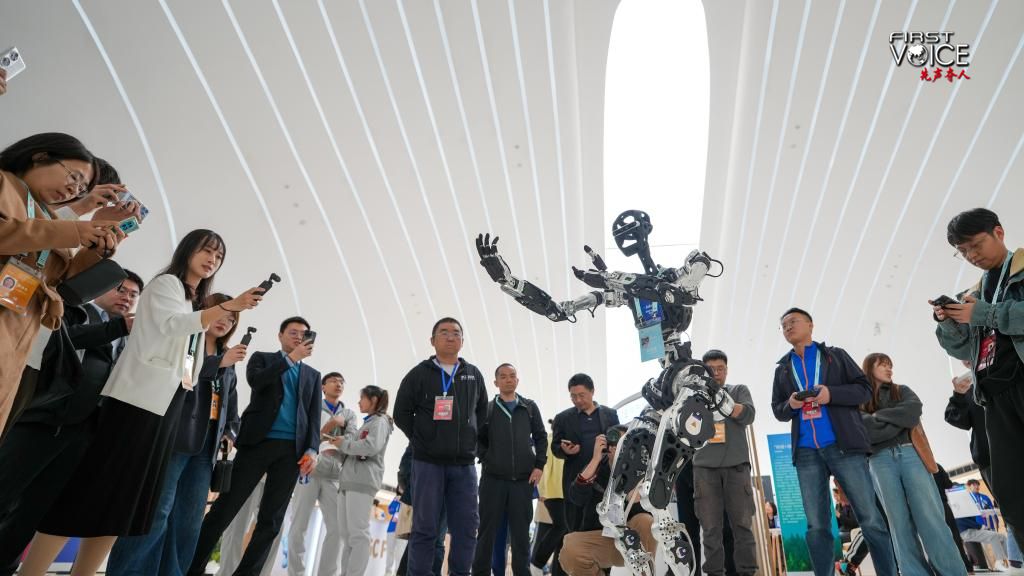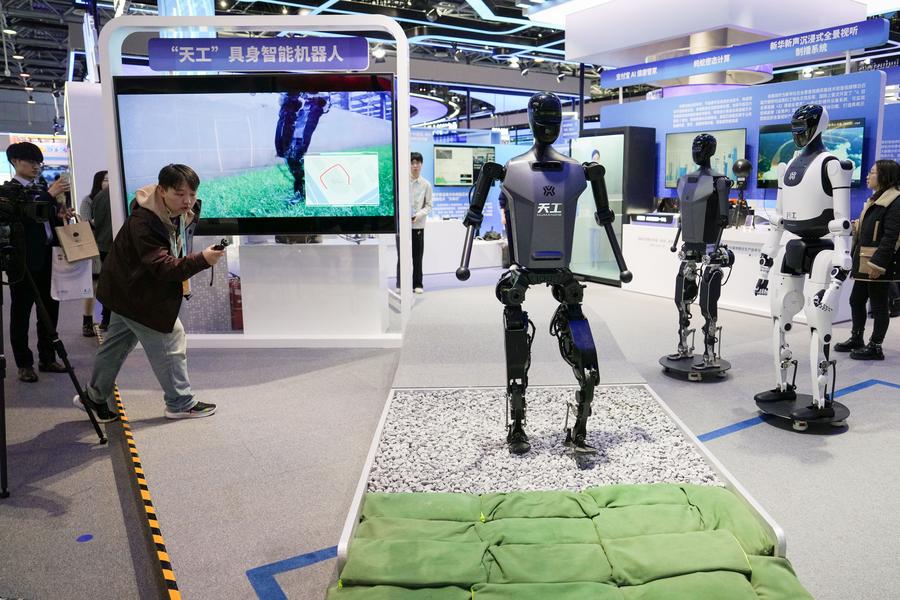
A humanoid robot performs at Zhongguancun International Innovation Center, venue for the 2025 Zhongguancun Forum (ZGC Forum) Annual Conference, in Beijing, capital of China, March 27, 2025. [Photo/Xinhua]
Editor's note: CGTN's First Voice provides instant commentary on breaking stories. The column clarifies emerging issues and better defines the news agenda, offering a Chinese perspective on the latest global events.
China has risen from 20th position in 2012 to 10th in 2024 in the latest global innovation league table which was released by the Academy of Science and Technology for Development on Monday. The report, which evaluates the innovation capabilities of 40 nations collectively contributing over 85 percent of global GDP, noted that China's rise in the rankings is faster than any other country since 2012.
Combined factors explain China's rapid progress. To begin with, the Chinese government has made fostering innovation one of its central policy goals since 2012, with the aim of building the country into a science-tech powerhouse by 2035.
This year's government work report delivered to the annual meeting of the national legislature for deliberation last month has again highlighted innovation-driven development as a key priority.
"We should stay committed to innovation-driven development and make integrated progress in education, scientific and technological innovation, and talent cultivation, so as to consolidate the foundational and strategic underpinning for Chinese modernization," said Chinese Premier Li Qiang, highlighting the country's major tasks for 2025 in the government work report.
Determination alone cannot build China into a scientific powerhouse without concrete actions.
In recent years, China has been actively deepening reforms in the science-tech system. On Tuesday, the country unveiled a plan to strengthen its financial services for tech-based enterprises, outlining measures to bolster services in technology insurance, promote pilot projects of tech-related finance policies and strengthen cooperation between government agencies, technology firms and financial institutions.
Apart from policy support, China has been increasing its investments in research and experimental development (R&D). Latest data from China's National Bureau of Statistics shows that the country's R&D expenditure surpassed 3.6 trillion yuan ($494.69 billion) in 2024, ranking it as the second-highest across the world.
These efforts have unsurprisingly yielded positive results.
The rapid development of artificial intelligence (AI), for instance, has become an innovation pillar for China's high-quality growth.
By 2024, China had nearly 200 operational generative AI models, serving over 600 million users, according to Xinhua News Agency. Additionally, China's industrial robot installations comprised more than half of the global total, while the country took a leading role in establishing international standards for elderly-care robots.

A humanoid robot walks at Zhongguancun International Innovation Center, venue for the 2025 Zhongguancun Forum (ZGC Forum) Annual Conference, in Beijing, capital of China, March 27, 2025. [Photo/Xinhua]
More impressively, China is to launch the world's first flying taxis. On Saturday, Chinese regulators granted the first-ever approvals for two companies – EHang Holdings and Hefei Hey Airlines – to operate autonomous passenger drones. This means the two firms are cleared to offer commercial passenger services including sightseeing tours.
"The low-altitude economy is a new growth driver, and it will be an important engine to push the high-speed development of China's economy," Cheng Bolin, vice-president of the low-altitude unit at the China Information Association, said at an industry conference last month.
Innovation is what makes China's high-quality economic growth possible.
"The country (China) is turning from the world's factory to the world's innovation hub. We've seen developments across clean tech, artificial intelligence, as well as biopharmaceuticals that are all very encouraging," China Daily quoted Ben Simpfendorfer, a partner at consultancy Oliver Wyman, as saying.
"China has been searching for a lever to improve productivity over the last 10 years and move on from old growth models. Artificial intelligence provides that lever," Simpfendorfer added.
China still has progress to make in other areas, including basic research. The importance of advancing the reform of research institutes, exploring new models for national laboratories and enabling international and regional centers for tech innovation were also highlighted in this year's government work report.
As Chinese President Xi Jinping has stressed on multiple occasions, in order for China to become a science-tech powerhouse, it needs to produce groundbreaking innovations, exert global scientific influence, attract talents, and maintain world-class innovation governance.
China is steadily moving forward in this direction, and its achievements are increasingly recognized by the international community.

 中文
中文



